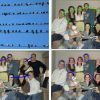Free Online Productivity Tools
i2Speak
i2Symbol
i2OCR
iTex2Img
iWeb2Print
iWeb2Shot
i2Type
iPdf2Split
iPdf2Merge
i2Bopomofo
i2Arabic
i2Style
i2Image
i2PDF
iLatex2Rtf
Sci2ools
162
click to vote
CVPR
2009
IEEE
2009
IEEE
Understanding Images of Groups of People
In many social settings, images of groups of people are captured. The structure of this group provides meaningful context for reasoning about individuals in the group, and about the structure of the scene as a whole. For example, men are more likely to stand on the edge of an image than women. Instead of treating each face independently from all others, we introduce contextual features that encapsulate the group structure locally (for each person in the group) and globally (the overall structure of the group). This “social context” allows us to accomplish a variety of tasks, such as such as demographic recognition, calculating scene and camera parameters, and even event recognition. We perform human studies to show this context aids recognition of demographic information in images of strangers.
Related Content
| Added | 09 May 2009 |
| Updated | 31 Mar 2011 |
| Type | Conference |
| Year | 2009 |
| Where | CVPR |
| Authors | Andrew C. Gallagher, Tsuhan Chen |
Comments (0)



